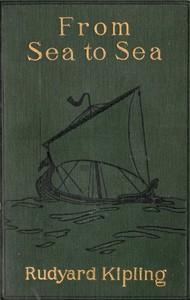Read this ebook for free! No credit card needed, absolutely nothing to pay.
Words: 171399 in 19 pages
This is an ebook sharing website. You can read the uploaded ebooks for free here. No credit cards needed, nothing to pay. If you want to own a digital copy of the ebook, or want to read offline with your favorite ebook-reader, then you can choose to buy and download the ebook.


: Encyclopaedia Britannica 11th Edition Calhoun to Camoens Volume 5 Slice 1 by Various - Encyclopedias and dictionaries
by a mountain wall, which is broken down in but a single place, the gap behind the Golden Gate at San Francisco. Through this passes the entire drainage of the interior. The length of the valley is about 450 m., its breadth averages about 40 m. if the lower foothills be included, so that the entire area is about 18,000 sq. m. The drainage basin measured from the water-partings of the enclosing mountains is some three times as great. From the mouth of the Sacramento to Redding, at the northern head of the valley, the rise is 552 ft. in 192 m., and from the mouth of the San Joaquin southward to Kern lake it is 282 ft. in 260 m.
Two great rivers drain this central basin,--the San Joaquin, whose valley comprises more than three-fifths of the entire basin, and the Sacramento, whose valley comprises the remainder. The San Joaquin is a very crooked stream flowing through a low mud-plain, with tule banks; the Sacramento is much less meandering, and its immediate basin, which is of sandy loam, is higher and more attractive than that of the San Joaquin. The eastward flanks of the Coast Range are very scantily forested, and they furnish not a single stream permanent enough to reach either the Sacramento or San Joaquin throughout the dry season. On the eastern side of both rivers are various important tributaries, fed by the more abundant rains and melting snows of the western flank of the Sierra; but these streams also shrink greatly in the dry season. The Feather, emptying into the Sacramento river about 20 m. N. of the city of Sacramento, is the most important tributary of the Sacramento river. A striking feature of the Sacramento system is that for 200 m. north of the Feather it does not receive a single tributary of any importance, though walled in by high mountains. Another peculiar and very general feature of the drainage system of the state is the presence of numerous so-called river "sinks," where the waters disappear, either directly by evaporation or after flowing for a time beneath the surface. These "sinks" are therefore not the true sinks of limestone regions. The popular name is applied to Owen's lake, at the end of Owen's river; to Mono lake, into which flow various streams rising in the Sierra between Mount Dana and Castle Peak; and to Death Valley, which contains the "sink" of the Amargosa river, and evidently was once an extensive lake, although now only a mud-flat in ordinary winters, and a dry, alkaline, desert plain in summer. All these lakes, and the other mountain lakes before referred to, show by the terraces about them that the water stood during the glacial period much higher than it does now. Tulare lake, which with Buena Vista lake and Kern lake receives the drainage of the southern Sierra, shows extreme local variations of shore-line, and is generally believed to have shrunk extremely since 1850, though of this no adequate proof yet exists. In 1900 it was about 200 sq. m. in area. In wet seasons it overflows its banks and becomes greatly extended in area, discharging its surplus waters into the San Joaquin; but in dry seasons the evaporation is so great that there is no such discharge. The drainage of Lassen, Siskiyou and Modoc counties has no outlet to the sea and is collected in a number of great alkaline lakes.
Finally along the sea below Pt. Conception are fertile coastal plains of considerable extent, separated from the interior deserts by various mountain ranges from 5000 to 7000 ft. high, and with peaks much higher . Unlike the northern Sierra, the ranges of Southern California are broken down in a number of places. It is over these passes--Soledad, 2822 ft., Cajon, San Gorgonio, 2560 ft.--that the railways cross to the coast. That part of California which lies to the south and east of the southern inosculation of the Coast Range and the Sierra comprises an area of fully 50,000 sq. m., and belongs to the Basin Range region. For the most part it is excessively dry and barren. The Mohave desert--embracing Kern, Los Angeles and San Bernardino, as also a large part of San Diego, Imperial and Riverside counties--belong to the "Great Basin," while a narrow strip along the Colorado river is in the "Open Basin Region." They have no drainage to the sea, save fitfully for slight areas through the Colorado river. The Mohave desert is about 2000 ft. above the sea in general altitude. The southern part of the Great Basin region is vaguely designated the Colorado desert. In San Diego, Imperial and Riverside counties a number of creeks or so-called rivers, with beds that are normally dry, flow centrally toward the desert of Salton Sink or "Sea"; this is the lowest part of a large area that is depressed below the level of the sea,--at Salton 263 ft., and 287 ft. at the lowest point. In 1900 the Colorado river was tapped south of the Mexican boundary for water wherewith to irrigate land in the Imperial Valley along the Southern Pacific railway, adjoining Salton Sea. The river enlarged the canal, and finding a steeper gradient than that to its mouth, was diverted into the Colorado desert, flooding Salton Sea; and when the break in this river was closed for the second time in February 1907, though much of its water still escaped through minor channels and by seepage, a lake more than 400 sq. m. in area was left. A permanent 60 ft. masonry dam was completed in July 1907. The region to the east of the Sierra, likewise in the Great Basin province, between the crest of that range and the Nevada boundary, is very mountainous. Owen's river runs through it from north to south for some 180 m. Near Owen's lake the scenery is extremely grand. The valley here is very narrow, and on either side the mountains rise from 7000 to 10,000 ft. above the lake and river. The Inyo range, on the east, is quite bare of timber, and its summits are only occasionally whitened with snow for a few days during the winter, as almost all precipitation is cut off by the higher ranges to the westward. Still further to the east some 40 m. from the lake is Death Valley --the name a reminder of the fate of a party of "forty-niners" who perished here, by thirst or by starvation and exposure. Death Valley, some 50 m. long and on an average 20-25 m. broad from the crests of the inclosing mountain ranges , constitutes an independent drainage basin. It is below sea level , and altogether is one of the most remarkable physical features of California. The mountains about it are high and bare and brilliant with varied colours. The Amargosa river, entering the valley from Nevada, disappears in the salty basin. Enormous quantities of borax, already exploited, and of nitrate of soda, are known to be present in the surrounding country, the former as almost pure borate of lime in Tertiary lake sediments.
The physiography of the state is the evident determinant of its climate, fauna and flora. California has the highest land and the lowest land of the United States, the greatest variety of temperature and rainfall, and of products of the soil.
Along both the Coast Range and the Sierra considerable rainfall is certain, although, owing to the slight snow accumulations of the former, its streams are decidedly variable. A heavy rain-belt, with a normal fall of more than 40 in., covers all the northern half of the Sierra and the north-west counties; shading off from this is the region of 10-20 in. fall, which covers all the rest of the state save Inyo, Kern and San Bernardino counties, Imperial county and the eastern portion of Riverside county; the precipitation of this belt is from 0 to 10 in. In excessively dry years the limits of this last division may include all of the state below Fresno and the entire Central Valley as well. In the mountains the precipitation increases with the altitude; above 6000 or 7000 ft. it is almost wholly in the form of snow; and this snow, melting in summer, is of immense importance to the state, supplying water once for placer mining and now for irrigation. The north-west counties are extremely wet; many localities here have normal rainfalls of 60-70 in. and even higher annually, while in extreme seasons as much as 125 in. falls. Along the entire Pacific Coast, but particularly N. of San Francisco, there is a night fog from May to September. It extends but a few miles inland, but within this belt is virtually a prolongation of the rainy season and has a marked effect on vegetation. Below San Francisco the precipitation decreases along the coast, until at San Diego it is only about 10 in. The south-east counties are the driest portions of the United States. At Ogilby, Volcano, Indio and other stations on the Southern Pacific line the normal annual precipitation is from 1.5 to 2.5 in.; and there are localities near Owen's lake, even on its very edge, that are almost dry. For days in succession when it storms along the Southern California coasts and dense rain clouds blow landwards to the mountains, leaving snow or rain on their summits, it has been observed that within a few miles beyond the ridge the contact of the desert air dissipates the remaining moisture of the clouds into light misty masses, like a steam escape in cold air. The extreme heat of the south-east is tempered by the extremely low humidity characteristic of the Great Basin, which in the interior of the two southernmost counties is very low. The humidity of places such as Fresno, Sacramento and Red Bluff in the valley varies from 48 to 58. Many places in northern, southern, central, mountain and southern coastal California normally have more than 200 perfectly clear days in a year; and many in the mountains and in the south, even on the coast, have more than 250. The extreme variability in the amount of rainfall is remarkable. The effects of a season of drought on the dry portions of the state need not be adverted to; and as there is no rain or snow of any consequence on the mountains during summer, a succession of dry seasons may almost bare the ranges of the accumulated stock of previous winter snows, thus making worse what is already bad.
The Colorado desert is the hottest part of the United States. Along the line of the Southern Pacific the yearly extreme is frequently from 124? to 129? F. . At the other extreme, temperatures of -20? to -36? are recorded yearly on the Central Pacific line near Lake Tahoe. The normal annual means of the coldest localities of the state are from 37? to 44? F.; the monthly means from 20? to 65? F. The normal annual means on Indio, Mammoth Tanks, Salton and Volcano Springs are from 73.9? to 78.4 F.; the monthly means from 52.8? to 101.3? . The normal trend of the annual isotherms of the state is very simple: a low line of about 40? circles the angle in the Nevada boundary line; 50? normally follows the northern Sierra across the Oregon border; lines of higher temperature enclose the Great Valley; and lines of still higher temperature--usually 60? to 70?, in hotter years 60? to 75?--run transversely across the southern quarter of the state.
Another weather factor is the winds, which are extremely regular in their movements. There are brisk diurnal sea-breezes, and seasonal trades and counter-trades. Along the coast an on-shore breeze blows every summer day; in the evening it is replaced by a night-fog, and the cooler air draws down the mountain sides in opposition to its movement during the day. In the upper air a dry off-shore wind from the Rocky Mountain plateau prevails throughout the summer; and in winter an on-shore rain wind. The last is the counter-trade, the all-year wind of Alaska and Oregon; it prevails in winter even off Southern California.
There is the widest and most startling variety of local climates. At Truckee, for example, lying about 5800 ft. above the sea near Lake Tahoe, the lowest temperature of the year may be -25? F. or colder, when 70 m. westward at Rocklin, which lies in the foothills about 250 ft. above the sea, the mercury does not fall below 28?. Snow never falls at Rocklin, but falls in large quantity at Truckee; ice is the crop of the one, oranges of the other, at the same time. There are points in Southern California where one may actually look from sea to desert and from snow to orange groves. Distance from the ocean, situation with reference to the mountain ranges, and altitude are all important determinants of these climatic differences; but of these the last seems to be most important. At any rate it may be said that generally speaking the maximum, minimum and mean temperatures of points of approximately equal altitude are respectively but slightly different in northern or southern California.
Death Valley surpasses for combined heat and aridity any meteorological stations on earth where regular observations are taken, although for extremes of heat it is exceeded by places in the Colorado desert. The minimum daily temperature in summer is rarely below 70? F. and often above 90? F. , while the maximum may for days in succession be as high as 120? F. A record of 6 months showed an average daily relative humidity of 30.6 in the morning and 15.6 in the evening, and the humidity sometimes falls to 5. Yet the surrounding country is not devoid of vegetation. The hills are very fertile when irrigated, and the wet season develops a variety of perennial herbs, shrubs and annuals.
Fish are abundant. The United States fish commission, and an active state commission established in 1869, have done much to preserve and increase this source of food. In 1904 the yield of the fisheries of the three Pacific Coast states was 168,600,000 lbs., valued at ,681,000,--nearly half that of the New England states, more than one-third that of the Middle Atlantic states and more than that of the South Atlantic and Gulf states combined. Of the total, California yielded between a quarter and a third. A third of her fish comes from the Sacramento river. Some 230--more or less--marine food fishes are to be found in the market at San Francisco. The exports of fish from that port from 1892-1899 were valued at from ,000,000 to ,500,000 annually. Native oysters are small and of peculiar flavour; eastern varieties also are fattened, but not bred in California waters. Shrimp are abundant; the shrimp fishers are Chinese and four-fifths of the catch is exported to China. Sturgeon were once the cheapest fish after salmon; to-day, despite all efforts to increase the supply, they are the dearest. Salmon, once threatened with extinction, have been saved, maintained in good supply, and indeed have probably regained their pristine abundance. Shad and striped bass are both very abundant and cheap. Black bass, flounders, terrapin, sea-turtles, perch, turbot, sole and catfish are also common. Great herds of seals once lay like toll-gatherers off the Golden Gate and other bays of the coast, taking a large share of the salmon and other fish; but they are no longer common. The sea-lions sometimes raid the rivers for 100 m. inland. They have greatly increased since hunting them for their hides and oil ceased to be profitable, and thousands sometimes gather on the Farallones, off the Golden Gate.
In 1900 California ranked eleventh among the states in total value of farm property and in 1899 fourteenth in the value of farm products . The growth of the former from 1890 to 1900 was only 2.5%, one of the smallest increases among all the states.
The pastoral period extended from 1769 to 1848. The live-stock industry was introduced by the Franciscans and flourished exceedingly. In 1834, when the missions had already passed their best days, there were some 486,000 cattle, horses, mules and asses on the ranges, and 325,000 small animals, principally sheep. Throughout the pre-American period stock-raising was the leading industry; it built up the prosperity of the missions, largely supported the government and almost exclusively sustained foreign commerce. Hides and tallow were the sum and substance of Californian economy. Horses were slaughtered wholesale at times to make way for cattle on the ranges. There was almost no dairying; olive oil took the place of butter, and wine of milk, at the missions; and in general indeed the Mexicans were content with water. In the development of the state under the American regime the live-stock industry has been subordinate. A fearful drought in 1862-1864 greatly depressed it, and especially discouraged cattle ranching. Sheep then became of primary importance, until the increase of the flocks threatened ranges and forests with destruction. As late as 1876 there were some 7,000,000 sheep, in 1900 only 2,581,000, and in 1906 only 1,750,000. In the total value of all live stock in 1900 the rank of the state was 15th in the Union, and in value of dairy products in 1899 12th. The live-stock industry showed a tendency to decline after 1890, and the dairy industry also, despite various things--notably irrigation and alfalfa culture--that have favoured them.
Free books android app tbrJar TBR JAR Read Free books online gutenberg
More posts by @FreeBooks

: The Eagle's Nest by Cartwright S E Rainey W William Illustrator - Children Juvenile fiction; Tree houses Juvenile fiction






